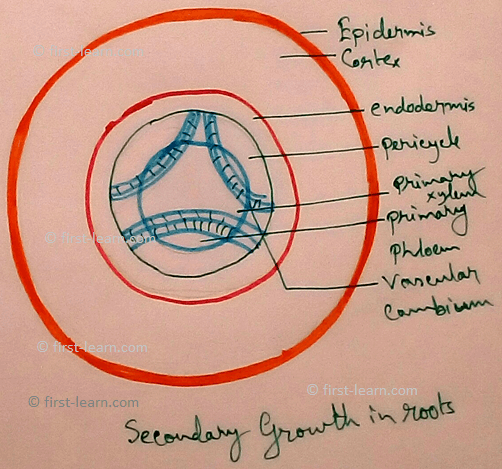Secondary Growth of Roots
Secondary growth is observed in vascular cambium and phellogen of dicot roots. It is seen that vascular cambium can be formed secondarily from conjunctive parenchyma and part of pericycle just lying opposite to the protoxylem points. Initially vascular cambium is seems to be wavy but later on it becomes circular and vascular cambium is derived from pericycle, which is form primary vascular rays. At some other places it forms secondary xylem on the inner side and secondary phloem on the outside. Secondary vascular rays are observed in different places whereas primary vascular rays are multiseriate at the beginning and uniseriate on later.
Secondary phloem do not persist as a result when it is become operational the previous phloem get crushed before it becomes operational. Secondary xylem and on the other hand primary xylem both are persist.
Annual rings are not present, because the areas where the roots of the plants grow are, very less variations of temperature of soil (due to less variations of season) are observed.
Cork cambium or phellogen are formed from pericycle which produces phellem or cork on the outside and on the other hand secondary cortex or phelloderm on the inner side. These three are together called periderm. In this case cortex and epiblema peel off, cork or phellem is made of dead cells. Lenticular are observed in different places.
Anomalous secondary growth of roots-
In some plants storage roots are observed where accessory cambial rings are formed which cut out less or little secondary xylem and more storage parenchyma in secondary phloem. Example- Beet, sweet potato.
1. What do you mean by primary xylem and secondary xylem?
Primary xylem is derived from procambium during primary growth and is consists of protoxylem and metaxylem.
Secondary xylem is formed from vascular cambium during secondary growth.
2. What do you mean by primary phloem and secondary phloem?
Primary phloem is formed from procambium during primary growth. It may or may be not show differentiation into protophloem and metaphloem.
Secondary phloem is produced during the secondary growth of vascular cambium.
From Secondary Growth of Roots to HOME PAGE
Recent Articles
-
What Is Plasma? | Blood Plasma | Proteins | Nutrients | Cholesterol
Nov 07, 25 10:29 AM
Blood is a mobile fluid which is a connective tissue and is derived from the mesoderm like cell any other connective tissue. Colour of blood is reddish and that flows inside the blood vessels by means… -
Disorders of Respiratory System | Tuberculosis | Pleurisy | Emphysema
Oct 28, 25 11:39 PM
Tuberculosis is very common disease and is caused by a type of bacteria called Mycobacterium tuberculosis. This disease causes different trouble in the respiration and infection of several parts of th… -
Regulation of Respiration | Respiratory Centres | Inspiratory Area |
Oct 14, 25 12:13 AM
Respiratory Centre is the area that controls the rate of respiration and it is observed to be located in medulla oblongata and pons. Respiratory Centre has the following will dispersed components like… -
Explain Transport of Gases | External Respiration | Tissue Respiration
Oct 09, 25 11:35 PM
In humans gaseous exchange is completed in the following ways the steps are - External Respiration or Breathing - Breathing in false taking in of Oxygen and giving out of carbon dioxide in the body. M… -
Kind and Number of Teeth | Location of Teeth in Mouth | Care of Teeth
Sep 11, 25 12:52 AM
Kind and Number of Teeth






New! Comments
Have your say about what you just read! Leave me a comment in the box below.